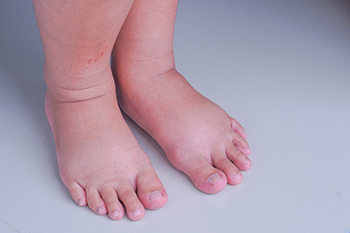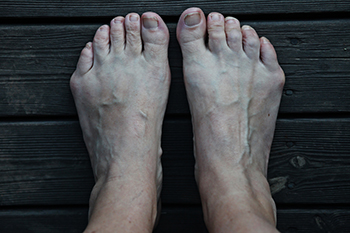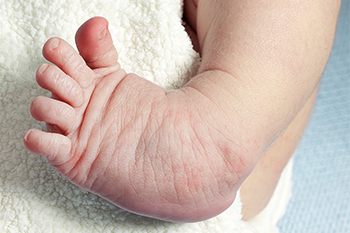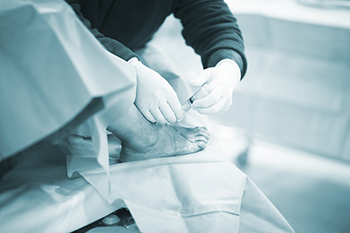
Swollen feet, a common occurrence, can be attributed to various factors that impact the delicate balance of fluid regulation in the body. One primary cause is fluid retention, often linked to prolonged periods of standing or sitting, particularly in hot weather. The force of gravity hinders efficient circulation, leading to fluid pooling in the lower extremities. Additionally, dietary choices high in sodium can contribute to water retention, exacerbating swelling. Injuries or trauma, such as sprains or fractures, may trigger localized swelling as the body's natural response to inflammation. Conditions like venous insufficiency or deep vein thrombosis disrupt blood flow, promoting fluid accumulation. Pregnancy and hormonal fluctuations can also lead to swelling in the feet. If your feet are swollen, it is suggested that you consult a podiatrist who can determine what the cause is, and offer appropriate relief methods.
Swollen feet can be a sign of an underlying condition. If you have any concerns, contact one of our podiatrists of McKinney Podiatric Associates, PA. Our doctors can provide the care you need to keep you pain-free and on your feet.
Swollen feet are a common ailment among pregnant women and people who stand or sit for extended periods. Aging may increase the possibility of swollen feet and patients who are obese often notice when their feet are swelling too. There may be medical reasons why swollen feet occur:
Swollen feet can also be caused by bone and tendon conditions, including fractures, arthritis, and tendinitis. Additionally, there may be skin and toenail conditions and an infection may cause the feet to swell. Patients who take medicine to treat high blood pressure may be prone to getting swollen feet.
Many patients elevate their feet to help relieve the swelling and this is generally a temporary remedy. When a podiatrist is consulted the reason behind the swelling can be uncovered and subsequently treated.
If you have any questions please feel free to contact one of our offices located in Pasadena, Baytown, League City, Houston, and Pearland,TX . We offer the newest diagnostic tools and technology to treat your foot and ankle needs.

Pregnancy is a transformative journey, both physically and emotionally. While many anticipate changes in their bodies, some may not be aware of the potential foot conditions that can arise during this time. One common issue is edema, or swelling of the feet and ankles, which results from increased blood volume and the pressure on leg veins. This can cause discomfort, but it is often temporary. Another condition linked to pregnancy is flat feet. Hormonal changes during pregnancy can affect the ligaments in the feet, leading to a decrease in arch height. This can contribute to foot pain and discomfort. Additionally, weight gain can place added stress on the feet, often causing pain and fatigue. The expanding uterus may also shift the center of gravity, altering the gait and potentially causing problems like plantar fasciitis. Pregnancy can bring about various foot challenges, but with proper care, many of these issues can be managed or prevented. If you have developed any type of foot conditions during your pregnancy, it is suggested that you schedule an appointment with a podiatrist who can monitor any foot pain or discomfort you may be experiencing.
Pregnant women with swollen feet can be treated with a variety of different methods that are readily available. For more information about other cures for swollen feet during pregnancy, consult with one of our podiatrists from McKinney Podiatric Associates, PA. Our doctors will attend to all of your foot and ankle needs.
What Foot Problems Can Arise During Pregnancy?
One problem that can occur is overpronation, which occurs when the arch of the foot flattens and tends to roll inward. This can cause pain and discomfort in your heels while you’re walking or even just standing up, trying to support your baby.
Another problem is edema, or swelling in the extremities. This often affects the feet during pregnancy but tends to occur in the later stages.
How Can I Keep My Feet Healthy During Pregnancy?
If you have any questions please feel free to contact one of our offices located in Pasadena, Baytown, League City, Houston, and Pearland,TX . We offer the newest diagnostic and treatment technologies for all your foot and ankle needs.

Tailor's bunions, also known as bunionettes, present a unique challenge with a bony lump on the outside of the foot around the small toe joint. While tight and ill-fitting shoes can exacerbate the issue, the exact cause of bunionettes is not fully understood. Inherited factors and the natural shape of foot bones play a significant role in bunionette formation. Causes include previous toe joint injuries, joint hypermobility, age, inflammatory arthritic conditions, tight leg muscles, and neuromuscular conditions. Footwear can also play a significant role. Tailor's bunions can cause discomfort and pain by putting pressure on the joint, bursa, and surrounding nerves. Treatment can include rest and elevation, applying a cold compress, and choosing footwear with cushioned heels, and good arch support. Further, using insoles, engaging in regular stretching and foot exercises, and exploring activities that put minimal pressure on the feet, such as swimming, may help. Weight management may also be beneficial. Footwear to avoid include wearing high heels and tight shoes, in addition to prolonged standing and walking barefoot on hard surfaces. If you have a bunionette that is causing discomfort, it is suggested that you schedule an appointment with a podiatrist for an exam and treatment options.
If you are suffering from bunion pain, contact one of our podiatrists of McKinney Podiatric Associates, PA. Our doctors can provide the care you need to keep you pain-free and on your feet.
What Is a Bunion?
Bunions are painful bony bumps that usually develop on the inside of the foot at the joint of the big toe. As the deformity increases over time, it may become painful to walk and wear shoes. Women are more likely to exacerbate existing bunions since they often wear tight, narrow shoes that shift their toes together. Bunion pain can be relieved by wearing wider shoes with enough room for the toes.
Causes
Symptoms
In order to diagnose your bunion, your podiatrist may ask about your medical history, symptoms, and general health. Your doctor might also order an x-ray to take a closer look at your feet. Nonsurgical treatment options include orthotics, padding, icing, changes in footwear, and medication. If nonsurgical treatments don’t alleviate your bunion pain, surgery may be necessary.
If you have any questions, please feel free to contact one of our offices located in Pasadena, Baytown, League City, Houston, and Pearland,TX . We offer the newest diagnostic and treatment technologies for all your foot care needs.

Clubfoot, a congenital condition affecting newborns, is characterized by the abnormal positioning of the foot or feet. This condition is present at birth, with the infant's foot turning inward and downward, resembling the club's head. The primary causes of clubfoot are often linked to a combination of genetic and environmental factors. While the exact genetic mechanisms are not fully understood, there is evidence of familial predisposition. Environmental factors, such as intrauterine positioning or limited space in the womb, can also contribute to the development of clubfoot. This congenital anomaly affects the muscles, tendons, and bones in the foot, leading to a tightened Achilles tendon and an imbalance in the surrounding structures. Early detection and intervention are crucial for managing clubfoot effectively. Treatment options may include gentle stretching, casting, and, in some cases, surgical procedures to correct the foot's alignment and promote proper development. If your child has been born with clubfoot, it is strongly suggested that a podiatrist is on your healthcare team who can determine what the best treatment option is for this condition.
Congenital foot problems require immediate attention to avoid future complications. If you have any concerns, contact one of our podiatrists of McKinney Podiatric Associates, PA. Our doctors can provide the care you need to keep you pain-free and on your feet.
Congenital foot problems are deformities affecting the feet, toes, and/or ankles that children are born with. Some of these conditions have a genetic cause while others just happen. Some specific foot ailments that children may be born with include clubfeet, polydactyly/macrodactyly, and cleft foot. There are several other foot anomalies that can occur congenitally. What all of these conditions have in common is that a child may experience difficulty walking or performing everyday activities, as well as trouble finding footwear that fits their foot deformity. Some of these conditions are more serious than others. Consulting with a podiatrist as early as possible will help in properly diagnosing a child’s foot condition while getting the necessary treatment underway.
What are Causes of Congenital Foot Problem?
A congenital foot problem is one that happens to a child at birth. These conditions can be caused by a genetic predisposition, developmental or positional abnormalities during gestation, or with no known cause.
What are Symptoms of Congenital Foot Problems?
Symptoms vary by the congenital condition. Symptoms may consist of the following:
Treatment and Prevention
While there is nothing one can do to prevent congenital foot problems, raising awareness and receiving neonatal screenings are important. Early detection by taking your child to a podiatrist leads to the best outcome possible.
If you have any questions please feel free to contact one of our offices located in Pasadena, Baytown, League City, Houston, and Pearland,TX . We offer the newest diagnostic tools and technology to treat your foot and ankle needs.

Rheumatoid arthritis, or RA, is the most common form of inflammatory arthritis, and it often results in foot-related problems in up to 90 percent of those diagnosed. The foot can be an initial site for RA symptoms, with symptoms that include soreness, swelling, and joint erosion. A podiatrist can identify, diagnose, and treat these foot-related challenges, with an aim to alleviate pain, enhance function, and protect overall foot health. Their palliative foot care includes addressing distorted or altered nails, hard skin, calluses, and corns. A podiatrist also specializes in wound management, offering timely interventions for wounds and ulcers on the feet as they develop. Custom orthotics, ranging from soft cushions to firmer devices, can improve foot alignment and function. A podiatrist can contribute to joint protection, manage inflamed joints, suggest appropriate exercises, and provide insights into surgical options when necessary. Their comprehensive care extends beyond immediate foot concerns, aiming to enhance overall foot health and contribute to the well-being of those navigating the challenges of rheumatoid arthritis. For more information about managing foot problems associated with RA, it is suggested that you include a podiatrist as a permanent member of your medical team.
If you are dealing with pain in your feet and ankles, you may want to seek help from a podiatrist. Feel free to contact one of our podiatrists from McKinney Podiatric Associates, PA. Our doctors can provide the care you need to keep you pain-free and on your feet.
What Is a Podiatrist?
A podiatrist is a doctor of podiatric medicine who diagnoses and treats conditions of the foot, ankle, and related structures of the leg. Your podiatrist may specialize in a certain field such as sports medicine, wound care, pediatrics, and diabetic care. Podiatrists have the ability to become board certified through training, clinical experience, and then taking an exam.
What Do Podiatrists Do?
On a daily basis, a podiatrist may perform the following activities:
It is very important that you take care of your feet. It’s easy to take having healthy feet for granted, however foot problems tend to be among the most common health conditions. Podiatrists can help diagnose and treat a variety of feet related conditions, so it is crucial that you visit one if you need assistance.
If you have any questions please feel free to contact one of our offices located in Pasadena, Baytown, League City, Houston, and Pearland,TX . We offer the newest diagnostic and treatment technologies for all your foot and ankle needs.